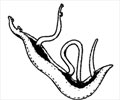New research gives that a parasitic infection common in China and Southeast Asia could be effectively diminished by controlling snail populations.
New research gives that a parasitic infection common in China and Southeast Asia could be effectively diminished by controlling snail populations.
Infection with schistosomes of various species affects some 200 million people worldwide, and can cause serious chronic illnesses, including liver failure. Steven Riley of the University of Hong Kong and collaborators analyzed infection patterns of the parasitic worm Schistosoma japonicum in fifty villages in Samar Province, the Philippines.Rates of infection among humans and animals have been found to differ among villages, and the researchers developed a mathematical model incorporating fecal parasite test results from thousands of people and animals (including, cats, pigs, dogs, water buffalo, and rats) to explain these differences.
Schistosomes are passed from mammals to fresh-water snails via feces, and then cycle back to infect mammals that contact water inhabited by infected snails. Using the mathematical model, the team found that transmission from snails to mammals was a more important factor in explaining the differences among villages than transmission from mammals to snails.
As with all scientific models, the findings of this one depend on the assumptions made to build the model. Nevertheless, the findings suggest that interventions to reduce the size of the snail population and the exposure of mammals to parasite-containing water might reduce human infection levels more effectively than interventions that interrupt other parts of the parasite’s life cycle.
The results also indicate that the contribution of water buffaloes to human S. japonicum infection in the Philippines is not particularly important. This finding contrasts with a recent study that identified water buffalo as the major mammalian reservoir for S. japonicum in China.(http://www.who.int/bulletin/volumes/85/7/06-034033/en/index.html), and suggests that further studies of t he transmission of S. japonicum by water buffalo are warranted before efforts are dedicated to treat or vaccinate water buffalo as a control measure against human S. japonicum infection.
In a related perspective article, Song Liang and Robert Spear, who were not involved in the study, discuss the findings and conclude that the “modeling approach can be a useful tool in exploring schistosomiasis transmission in other settings, and may even apply to other macroparasites.”
Advertisement
LIN/M






